If you are a swimming pool owner, and have had your pool for a long time, you might be familiar with green swimming pool syndrome, and how to fix it.
But if not, and you are new to owning pools and all of the joys of pool maintenance this post, drawn from personal experience may be of help.
When it comes to private swimming pools, perhaps a backyard pool, above ground, in ground or otherwise, there are two main sorts. These are chlorine pools and salt water chlorinated pools.
The aim of both systems is the same, to keep the water clean and safe to swim in. By safe, we mean keeping bacteria and algae at a non hazardous level.
The owner of a chlorine pool does this by putting a measured amount of chlorine in the pol and checking it. How much goes in depends on the size of the pool and the weather Hot weather and sun will cause the chlorine to break down quicker. Evaporation and rain will also affect the chlorine balance of a pool.
A salt water chlorinated pool still uses chlorine, but it does so by converting normal salt to chlorine.
When not enough chlorine is present in the pool, algae and bacteria will begin to multiply. They do this causing the water to go hazy. This is a warning sign.
If your pool starts to appear hazy, you be to either add chlorine or run your salt converter. At this stage your pool is not clean enough to swim in safely.
Swimming in a green pool runs the risk of ski irritation ad bacterial infections. If there is not enough free salt in the pool, the electrolytic converter will not have enough salt to convert to chlorine, so you will need to add salt first.
If you don't do this, the growth of algae and bacteria increases exponentially, and large clumps of algae will start to form. It is this green algae that gives the pool the green look.
By now, if you have a salt water pool it is now too far gone to recover using just the pools chlorinator. When a pool is clear and safe the salt water chlorine converter will make enough chlorine to keep things healthy but once the algae growth has rocketed most chlorinators will not make enough to reverse the situation.
You will need to shock treat your pool with a high dose of chlorine and algicide. I have covered that in another post here.
Salt water swimming pool maintenance - about my solar heated in ground salt water chlorinated pool
How I turned my green swimming pool into a beautiful clean and safe to swim in salt water chlorinated swimming pool. Has your pool gone green? Filled with yucky algae and bugs? Want to know how to fix a green swimming pool? Ours was - and here is how we fixed it. It is a solar heated in ground swimming pool in Melbourne Australia.Loads of pictures, including solar heating setup, filter and pump pictures, and equipment and accessory tips
Sunday, December 15, 2013
Why do swimming pools turn green? What makes a swimming go green in colour
Labels:
green pool,
green swimming pool,
Swimming pool,
swimming pools
Wednesday, December 11, 2013
Fixing a green swimming pool - step two - balancing the PH, hardness and alkalinity levels
Before we get stuck into the detail of this post about all things pool chemical, we need to set the scene.
We inherited a green pool. We needed to clean the pool and fix it. 35000 litres in capacity. Here's how. Before we can balance it we needed to shock it with chlorine and algae killer. This done, we let it settle for a few days before stirring again and running the filter.
After about ten or 12 days the pool was starting to look a bit more swimmable, however there was more work to be done before we could get swimming.
I needed to add salt - as it was a salt chlorinated pool, and I needed to be sure that the hardness level was right, as well as the Ph level. Too much acidity or alkalinity will affect pipes and liners, as well as the electrolytic converter that changes the sodium chloride - salt - into chlorine.
Now I did year 11 and 12 chemistry but this called for a specialist. So out came the trusty sample bottle - once the coca cola was sorted - and off we went back to Clark Rubber.
Now I do need to say that this is not an ad for this business, but they were very helpful. Most pool specialists would provide similar services I imagine. They told us that the water was too soft, and that we needed to raise the alkalinity - it was too acidic. And yes that means they sold us the necessary chemicals. Fair enough I say.
So we also bought three 20 kilo bags of pool salt and stirred the whole lot in to our 35000 litre inground solar heated swimming pool. Then ran the filters....and waited....and waited.....and.....
The salt level was perfect....
The PH is now perfect, as is the water hardness level....
All we needed to do was let the chlorinator do its job and run the filter a bit more. As the chlorine level came up our once murky swampy pool began to look very good indeed.
And the end result......
Check our friends directory for free business advertising
We inherited a green pool. We needed to clean the pool and fix it. 35000 litres in capacity. Here's how. Before we can balance it we needed to shock it with chlorine and algae killer. This done, we let it settle for a few days before stirring again and running the filter.
After about ten or 12 days the pool was starting to look a bit more swimmable, however there was more work to be done before we could get swimming.
I needed to add salt - as it was a salt chlorinated pool, and I needed to be sure that the hardness level was right, as well as the Ph level. Too much acidity or alkalinity will affect pipes and liners, as well as the electrolytic converter that changes the sodium chloride - salt - into chlorine.
Now I did year 11 and 12 chemistry but this called for a specialist. So out came the trusty sample bottle - once the coca cola was sorted - and off we went back to Clark Rubber.
Now I do need to say that this is not an ad for this business, but they were very helpful. Most pool specialists would provide similar services I imagine. They told us that the water was too soft, and that we needed to raise the alkalinity - it was too acidic. And yes that means they sold us the necessary chemicals. Fair enough I say.
So we also bought three 20 kilo bags of pool salt and stirred the whole lot in to our 35000 litre inground solar heated swimming pool. Then ran the filters....and waited....and waited.....and.....
The salt level was perfect....
The PH is now perfect, as is the water hardness level....
All we needed to do was let the chlorinator do its job and run the filter a bit more. As the chlorine level came up our once murky swampy pool began to look very good indeed.
And the end result......
 |
| Salt water chlorinated in ground swimming pool |
Check our friends directory for free business advertising
Tuesday, December 10, 2013
Swimming Pool Temperatures in Melbourne Australia
If you are thinking about getting a swimming a pool, or have just bought a house with a swimming pool, one of the questions on your mind might be something like this one...
"How often will we be able to use our pool? How many months of the year can you use an outdoor swimming pool in Melbourne"
This is a great question. If you have a pool, and it doesn't have some kind of heating attached to it, then the number of months and consequently the enjoyment you get out of it will be significantly decreased, compared to a pool with a heater.
Here are some temperatures recorded in our outdoor swimming pool in Melbourne, Victoria, Australia.
In September, the water temperature was 8 degrees celsius. Thats eight degrees above zero but still wetsuit swimming material, hardly swimsuit.
With a little solar heating, by mid October we were up to 12 degrees.....brrrrrr
In Early November we had our first round of warm days, with several days in the mid twenties. This gave the solar the first real chance to heat our pool It got all the way up to about 19 degrees. Still brisk but actually rather nice, from a swimming perspective, as a pool that gets to warm can actually be uncomfortable if you are doing any sort of distance swim training.
So from Mid November onwards the pool was good to swim in....now lets see how long that lasts for.
We think with a bit of luck, we should still be using the pool well into next year, hopefully around March. Thats the beauty of solar heating. Its very cheap, and effective. So if we had a heater such as a gas or electric model, we might be inclined to not use it due to the costs. But with a solar heater the only real cost is the cost of running the pump....you beauty.
"How often will we be able to use our pool? How many months of the year can you use an outdoor swimming pool in Melbourne"
This is a great question. If you have a pool, and it doesn't have some kind of heating attached to it, then the number of months and consequently the enjoyment you get out of it will be significantly decreased, compared to a pool with a heater.
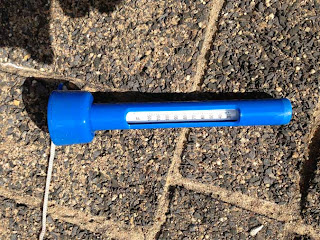 |
| Our swimming pool thermometer |
Here are some temperatures recorded in our outdoor swimming pool in Melbourne, Victoria, Australia.
In September, the water temperature was 8 degrees celsius. Thats eight degrees above zero but still wetsuit swimming material, hardly swimsuit.
With a little solar heating, by mid October we were up to 12 degrees.....brrrrrr
In Early November we had our first round of warm days, with several days in the mid twenties. This gave the solar the first real chance to heat our pool It got all the way up to about 19 degrees. Still brisk but actually rather nice, from a swimming perspective, as a pool that gets to warm can actually be uncomfortable if you are doing any sort of distance swim training.
So from Mid November onwards the pool was good to swim in....now lets see how long that lasts for.
We think with a bit of luck, we should still be using the pool well into next year, hopefully around March. Thats the beauty of solar heating. Its very cheap, and effective. So if we had a heater such as a gas or electric model, we might be inclined to not use it due to the costs. But with a solar heater the only real cost is the cost of running the pump....you beauty.
A directory of wedding and services businesses in Australia
Labels:
Australia,
Melbourne,
pool heater,
pool heating,
pool temperatures,
Swimming pool
Monday, December 9, 2013
How Long Does it Take to Clean a Swimming Pool - Is An Automatic Pool Cleaner Worth It?
Read : Should I buy an automatic pool cleaning machine? The answer is Yes - here is why.
How long does it take to clean a backyard swimming pool?
Fantastic question. And to be blunt not one most people think about when getting a swimming pool. Perhaps they should.
Here's why you should plan for this. I have a medium sized salt water chlorinated swimming pool in my back yard. We are lucky, as we don't have trees everywhere dropping leaves into the pool, nor do we live in a super dusty environment which would mean lots of dirt and dust getting blown into the pool
We thought about buying an automatic pool cleaner, you know, one of the types that plugs onto the filter and just scrubs around by itself. These start at around two or three hundred dollars however, so I thought I would make do with a hand held vacuum attachment on the end of a long pole.
Every couple of days I spend about ten minutes scooping the leaves and larger debris out of the pool with a strainer. But after about a week a noticeable layer start to build up on the bottom of the pool. This build up is actually fine leaf litter, dead bugs and insects, dirt and dust.
It's a perfect breeding ground for bacteria and algae. In fact, I have noticed that if I don't clear it out the pool starts to go hazy, which means its coming to life literally. So every week I vacuum the pool out by hand.
Well. This brings it up to a nice safe sparkling clear water look, idea for swimming in and splashing about. It takes me about half an hour. So if we multiply that half an hour by 100 which is the number of weeks in two years we get 50 hours, but lets say three years instead which is 75 hours.
The cost of the automatic pool cleaner works out to be about $4 per hour over the three years. In short, by doing it myself I am saving about $4 per hour. Not a great return really.
I think I am going back to the swimming pool shop to buy an automatic pool cleaner sometime soon!
How long does it take to clean a backyard swimming pool?
Fantastic question. And to be blunt not one most people think about when getting a swimming pool. Perhaps they should.
Here's why you should plan for this. I have a medium sized salt water chlorinated swimming pool in my back yard. We are lucky, as we don't have trees everywhere dropping leaves into the pool, nor do we live in a super dusty environment which would mean lots of dirt and dust getting blown into the pool
We thought about buying an automatic pool cleaner, you know, one of the types that plugs onto the filter and just scrubs around by itself. These start at around two or three hundred dollars however, so I thought I would make do with a hand held vacuum attachment on the end of a long pole.
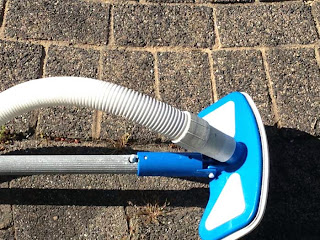 |
| My swimming pool cleaning head |
Every couple of days I spend about ten minutes scooping the leaves and larger debris out of the pool with a strainer. But after about a week a noticeable layer start to build up on the bottom of the pool. This build up is actually fine leaf litter, dead bugs and insects, dirt and dust.
It's a perfect breeding ground for bacteria and algae. In fact, I have noticed that if I don't clear it out the pool starts to go hazy, which means its coming to life literally. So every week I vacuum the pool out by hand.
Well. This brings it up to a nice safe sparkling clear water look, idea for swimming in and splashing about. It takes me about half an hour. So if we multiply that half an hour by 100 which is the number of weeks in two years we get 50 hours, but lets say three years instead which is 75 hours.
The cost of the automatic pool cleaner works out to be about $4 per hour over the three years. In short, by doing it myself I am saving about $4 per hour. Not a great return really.
I think I am going back to the swimming pool shop to buy an automatic pool cleaner sometime soon!
Check out our friendly wedding blog!
Labels:
Automatic pool cleaners,
buy pool cleaners,
clean a pool,
pool cleaning,
pool vacuum,
Swimming pool,
swimming pool cleaning
Sunday, December 8, 2013
Fixing a green swimming pool : Step one - the shock treatment using chlorine
Swimming Pool Help - A Green Pool!
Actually that's not strictly true. The first step we took towards rectifying the green pool problem was to get some information, and some good advice from a pool professional.
Thinking I was doing the right thing, I took a nice big sample of pool water down to our local Clark Rubber shop. Why Clark Rubber? Well they do sell rubber but they also sell a huge range of pool accessories, and most stores have a pool specialist on hand.
What I thought I needed was to check the Ph level for acidity or alkalinity, as well as the chlorine level. So in we went, green murky water in a jar, to the local shop. The water actually looked as if it was full of troll bogeys from Harry Potter. Eeeew.
When we got there, the pool expert politely explained that we could measure the chlorine level, but the amount of algae and bacteria in the pool water meant that we had several things to deal with
These were :
All of the biological activity in the water would mean that the acidity level - or PH - would change constantly. So we had to stop that before addressing anything else.
And that the salt water chlorinator woukd not, on its own, be able to reverse the green pool situation. The pools chlorine level was very low - way under the required concentration to kill algae and bugs. The bacteria in the pool was due to the backswimmers and frogs living and excreting in the water.
We needed to shock dose the pool with chlorine and add an algicide. If you don't know what an algicide is, its a chemical that kills algae. I think it was a potassium based chemical because it was purple.
These chemicals cost about 70 dollars or so, and while we were there we also bought a new pool vacuum head for about $40. As you may have seen in our earlier post about what sorts of pool tools you might need compared with what we had received you will know why.
So in went the chemicals. Bearing in mind that this is a salt water chlorinated in ground pool of about 35,000 liters in volume that's not exactly expensive. I would say quite cheap.
The concentrated chlorine was in a solid granulated form, and we had to dissolve it first in a bucket of water, then add it to the pool while the filter was running. If we had added straight solid chlorine granules to the pool it apparently could have damaged the liner.
The algae killing chemical was a liquid, and the whole lot went straight in. Then we ran the filter and pump for a while, This spread the chemicals throughout the pool.
It took about ten days for the chemicals to do their job. The green slowly faded, and the pool became clearer but was still a bit murky.
Next step : Balancing the water and adding salt so the electrolytic chlorine converter could do its job!
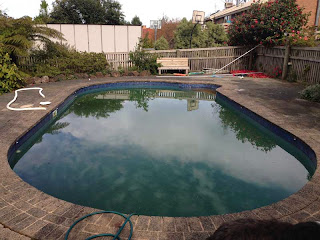 |
| It really looked this green |
Actually that's not strictly true. The first step we took towards rectifying the green pool problem was to get some information, and some good advice from a pool professional.
Thinking I was doing the right thing, I took a nice big sample of pool water down to our local Clark Rubber shop. Why Clark Rubber? Well they do sell rubber but they also sell a huge range of pool accessories, and most stores have a pool specialist on hand.
What I thought I needed was to check the Ph level for acidity or alkalinity, as well as the chlorine level. So in we went, green murky water in a jar, to the local shop. The water actually looked as if it was full of troll bogeys from Harry Potter. Eeeew.
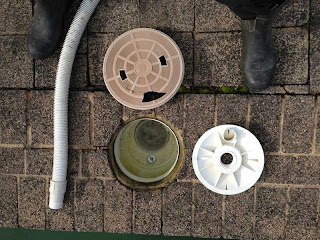 |
| This water is meant to be clear |
When we got there, the pool expert politely explained that we could measure the chlorine level, but the amount of algae and bacteria in the pool water meant that we had several things to deal with
These were :
All of the biological activity in the water would mean that the acidity level - or PH - would change constantly. So we had to stop that before addressing anything else.
And that the salt water chlorinator woukd not, on its own, be able to reverse the green pool situation. The pools chlorine level was very low - way under the required concentration to kill algae and bugs. The bacteria in the pool was due to the backswimmers and frogs living and excreting in the water.
We needed to shock dose the pool with chlorine and add an algicide. If you don't know what an algicide is, its a chemical that kills algae. I think it was a potassium based chemical because it was purple.
These chemicals cost about 70 dollars or so, and while we were there we also bought a new pool vacuum head for about $40. As you may have seen in our earlier post about what sorts of pool tools you might need compared with what we had received you will know why.
So in went the chemicals. Bearing in mind that this is a salt water chlorinated in ground pool of about 35,000 liters in volume that's not exactly expensive. I would say quite cheap.
The concentrated chlorine was in a solid granulated form, and we had to dissolve it first in a bucket of water, then add it to the pool while the filter was running. If we had added straight solid chlorine granules to the pool it apparently could have damaged the liner.
The algae killing chemical was a liquid, and the whole lot went straight in. Then we ran the filter and pump for a while, This spread the chemicals throughout the pool.
It took about ten days for the chemicals to do their job. The green slowly faded, and the pool became clearer but was still a bit murky.
Next step : Balancing the water and adding salt so the electrolytic chlorine converter could do its job!
Labels:
chlorine shock treatment,
chlorine treatment,
clark rubber pool shop,
green pool,
pool,
pools,
Swimming pool
Why does my swimming pool filter stop working? It pumps fine at first then slows down, almost to a stop? Whats wrong?
Help! Our pool filter worked for a while then slowly stopped. The amount of water being pumped got slower and slower until the pump was working flat out but no water was coming out! Solved.
Here is the background : We bought a house with a nice big swimming pool in the back yard. When we moved in we found the previous owners had let it go green. Understandable, but inconvenient. We also noticed that at night the back yard was filled with the noise of croaking frogs...sounded beautiful but little did we realize then exactly where this noise was coming from.
We also found all of the pool cleaning equipment was worn out. So we replaced it.
We knew the filter and pump worked. We knew this because we had tested it when we moved in. It has two settings, one where the water pumped back into the pool is run under the water, and another which causes the water to sprinkle back in via a set of telltales that look like little fountains and sound lovely. So we thought we would simply filter all of the green stuff out and we would have a nice blue pool that was safe to swim in.
Hmmm how wrong we were. I should point out that at this stage I knew very little about the chemicals needed or salt water pool chemistry.
We gave the pool a good scrub and a stir. and turned the pump on. And it seemed to work. The pool cleared slowly, bit by bit. Then, after awhile I could almost make out the bottom of the pool. It was at that point I saw the tadpoles and clumps of frog eggs.
And slowly but surely the tell tales stopped working. The water flow slowed to a dribble. The pump was still working but nothing was happening. It was blocked.
This was going to be a bigger challenge than I realized.
What had caused this? Several things.
The algae and bugs had blocked the filter. As well as several frogs. So I cleared out the bugs and the frogs, and turned the pump on again. Noise but the water was not flowing, the jets were still blocked.
Not knowing what to do and not wanting to blow the swimming pool pump motor up or cause it to burn out, I switched it off. At least I had got rid of the bugs and the frogs. Right?
Within two days there were more frogs in the pool and more back swimmers....and tadpoles in my swimming pool?
That's right
So off we went in search of advice. The internet is great but when it comes to pools you just cannot beat a trained professional who knows all about salt water pool filters and pumps. So we went to the local pool shop. They explained how to work the pump switch, which would clean the pool filter system and get the jets working again. Here is a picture of it below. We cover the operation of this switch in detail, in another post.
They also told me that unless we sorted out the algae and bugs with the right chemicals, we would not be able to get our green swimming pool to crystal clear and clean.
And that was that. Next step ; putting the right chemicals into the pool to kill the algae and the bugs!
Tags : Swimming pool filter, filter stops working, blocked filter, blocked pool pump, broken pool filter, broken pool pump
Here is the background : We bought a house with a nice big swimming pool in the back yard. When we moved in we found the previous owners had let it go green. Understandable, but inconvenient. We also noticed that at night the back yard was filled with the noise of croaking frogs...sounded beautiful but little did we realize then exactly where this noise was coming from.
 |
| Our pool in the beginning - bit green isn't |
We also found all of the pool cleaning equipment was worn out. So we replaced it.
We knew the filter and pump worked. We knew this because we had tested it when we moved in. It has two settings, one where the water pumped back into the pool is run under the water, and another which causes the water to sprinkle back in via a set of telltales that look like little fountains and sound lovely. So we thought we would simply filter all of the green stuff out and we would have a nice blue pool that was safe to swim in.
 |
| Green pool water looking in the filter access point |
Hmmm how wrong we were. I should point out that at this stage I knew very little about the chemicals needed or salt water pool chemistry.
We gave the pool a good scrub and a stir. and turned the pump on. And it seemed to work. The pool cleared slowly, bit by bit. Then, after awhile I could almost make out the bottom of the pool. It was at that point I saw the tadpoles and clumps of frog eggs.
And slowly but surely the tell tales stopped working. The water flow slowed to a dribble. The pump was still working but nothing was happening. It was blocked.
This was going to be a bigger challenge than I realized.
What had caused this? Several things.
The algae and bugs had blocked the filter. As well as several frogs. So I cleared out the bugs and the frogs, and turned the pump on again. Noise but the water was not flowing, the jets were still blocked.
Not knowing what to do and not wanting to blow the swimming pool pump motor up or cause it to burn out, I switched it off. At least I had got rid of the bugs and the frogs. Right?
Within two days there were more frogs in the pool and more back swimmers....and tadpoles in my swimming pool?
That's right
So off we went in search of advice. The internet is great but when it comes to pools you just cannot beat a trained professional who knows all about salt water pool filters and pumps. So we went to the local pool shop. They explained how to work the pump switch, which would clean the pool filter system and get the jets working again. Here is a picture of it below. We cover the operation of this switch in detail, in another post.
They also told me that unless we sorted out the algae and bugs with the right chemicals, we would not be able to get our green swimming pool to crystal clear and clean.
And that was that. Next step ; putting the right chemicals into the pool to kill the algae and the bugs!
Tags : Swimming pool filter, filter stops working, blocked filter, blocked pool pump, broken pool filter, broken pool pump
Looking for the best wedding venues in Brisbane - no worries - check the link!
Labels:
blocked filter,
blocked pool pump,
broken pool filter,
broken pool pump,
filter stops working,
Swimming pool filter
Swimming pool cleaning tools post : Tools you might need to keep your pool clean
What sort of tools should I buy for my pool? And how much do pool cleaners and swimming pool cleaning equipment cost?
What great questions. In fact, you are not buying the tools for the pool, the tools are for YOU to clean said pool with. Yes?
So we bought a house with a pool. Yay we said, envisaging hours of splash filled fun in the sun, lazing beside the pool, no work involved. Floating around on pool toys with drink holders in them. Now that sounds more like it.
Seems we forgot to buy a house with a pool that had a pool cleaner guy, so guess what.....that meant pool cleaner guy had to be made. Forged in sweat and pain. Once a meek and mild mannered dad, morphed into a pool tool wielding pool cleaner guy.
Yep. Thumbs in pockets, bulging biceps, the works.
Who am I kidding lol. This is me we are talking about here.
So the house settled, we moved in, the boxes were unloaded, and once the dust had settled we meandered down to the back yard to check out the pool. It was green. And slimy.
And found to our dismay that the tools the previous owners had seemed to be using to clean the pool were all basically worn out. Knackered, no good, ready to go to that great big plastic recyclers in the sky. Or the council wheelie bin. So we thought lets get the cleaning equipment we need, give the pool a scrub and vacuum, run the filter and get rid of the algae.
Lets give you a few examples at what we started with.- have a look at the pictures. Not going to get far with these. Lets just say the sun had done a fair bit of damage to the pvc fittings
All pools need a leaf scoop. These are sometimes called strainers. They are usually a plastic frame, with a nylon net in the middle. Scoops or hand skimmers are mounted on a pole so you can reach the pool without bending. You use these to skim the surface of the pool, taking out floating leaves, bugs and other debris. When full, you shake them out. That's the theory. The one we inherited had more holes in it than grandma's stockings. In fact, the very first leaves we tried to skim caused the last bits of nylon to fail, leaving us with just a frame.
So we looked at the poles we received. All broken except one. Bonus, made of metal, so these could be recycled too. Well at least there was one.
How about a vacuum head for the pool. This seemed to work. Made of sturdy PVC, that had been left out in the sun for at least ten years, it worked fine. Till we tried to remove the vacuum hose. This caused the pool cleaners vacuum head to disintegrate. Hmm, time for a new vacuum head.
There was also a PVC sweep head for scrubbing the pool base. It suffered the same fate as the other plastic pool cleaning tool parts.
So off we went to our trusty pool shop, to buy new pool cleaning equipment. And to be honest, it wasn't as pain filled as we thought. Vacuum heads start at about $29.95 at Clark Rubber, all the way to the latest Dolphin Pool Cleaners, Frill Neks, or other automatics such as Kreepy Krauleys and the like.
We settled on the cheapest one there. This mostly did the job but be aware, the units with stiffer bristles or no wheels can sometimes damage the pool liner if used with too much force. Occupational hazard of being a bloke.
So after all of that, we now have a leaf scoop for our pool, a new vacuum head, some old aluminium poles, and a very old sand filter and pump. Now we can get started on cleaning our pool, getting it to turn from green to sparkling blue.
Tags : pool cleaners, pool tools, swimming pool cleaner, swimming pool cleaning. swimming pool equipment, frillnekWizard, Dolphin pool cleaner, Automatic pool cleaners, , leaf scoop, pool skimmers, swimming pool skimmers, pool skimmer
What great questions. In fact, you are not buying the tools for the pool, the tools are for YOU to clean said pool with. Yes?
So we bought a house with a pool. Yay we said, envisaging hours of splash filled fun in the sun, lazing beside the pool, no work involved. Floating around on pool toys with drink holders in them. Now that sounds more like it.
Seems we forgot to buy a house with a pool that had a pool cleaner guy, so guess what.....that meant pool cleaner guy had to be made. Forged in sweat and pain. Once a meek and mild mannered dad, morphed into a pool tool wielding pool cleaner guy.
Yep. Thumbs in pockets, bulging biceps, the works.
Who am I kidding lol. This is me we are talking about here.
So the house settled, we moved in, the boxes were unloaded, and once the dust had settled we meandered down to the back yard to check out the pool. It was green. And slimy.
And found to our dismay that the tools the previous owners had seemed to be using to clean the pool were all basically worn out. Knackered, no good, ready to go to that great big plastic recyclers in the sky. Or the council wheelie bin. So we thought lets get the cleaning equipment we need, give the pool a scrub and vacuum, run the filter and get rid of the algae.
Lets give you a few examples at what we started with.- have a look at the pictures. Not going to get far with these. Lets just say the sun had done a fair bit of damage to the pvc fittings
All pools need a leaf scoop. These are sometimes called strainers. They are usually a plastic frame, with a nylon net in the middle. Scoops or hand skimmers are mounted on a pole so you can reach the pool without bending. You use these to skim the surface of the pool, taking out floating leaves, bugs and other debris. When full, you shake them out. That's the theory. The one we inherited had more holes in it than grandma's stockings. In fact, the very first leaves we tried to skim caused the last bits of nylon to fail, leaving us with just a frame.
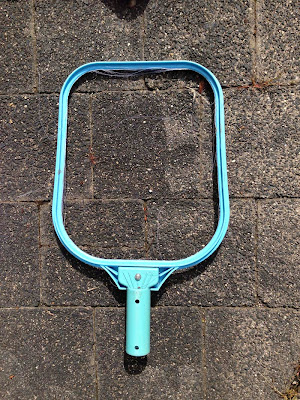 |
| The leaf scoop we inherited with our swimming pool |
So we looked at the poles we received. All broken except one. Bonus, made of metal, so these could be recycled too. Well at least there was one.
How about a vacuum head for the pool. This seemed to work. Made of sturdy PVC, that had been left out in the sun for at least ten years, it worked fine. Till we tried to remove the vacuum hose. This caused the pool cleaners vacuum head to disintegrate. Hmm, time for a new vacuum head.
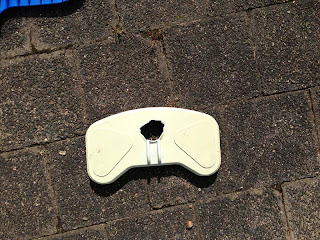 |
| The vacuum head we received with our swimming pool |
There was also a PVC sweep head for scrubbing the pool base. It suffered the same fate as the other plastic pool cleaning tool parts.
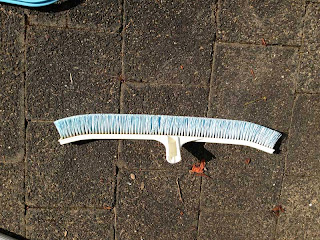 |
| Our pool sweeper - not much good is it? |
So off we went to our trusty pool shop, to buy new pool cleaning equipment. And to be honest, it wasn't as pain filled as we thought. Vacuum heads start at about $29.95 at Clark Rubber, all the way to the latest Dolphin Pool Cleaners, Frill Neks, or other automatics such as Kreepy Krauleys and the like.
We settled on the cheapest one there. This mostly did the job but be aware, the units with stiffer bristles or no wheels can sometimes damage the pool liner if used with too much force. Occupational hazard of being a bloke.
So after all of that, we now have a leaf scoop for our pool, a new vacuum head, some old aluminium poles, and a very old sand filter and pump. Now we can get started on cleaning our pool, getting it to turn from green to sparkling blue.
Tags : pool cleaners, pool tools, swimming pool cleaner, swimming pool cleaning. swimming pool equipment, frillnekWizard, Dolphin pool cleaner, Automatic pool cleaners, , leaf scoop, pool skimmers, swimming pool skimmers, pool skimmer
Labels:
Automatic pool cleaners,
leaf scoop,
pool cleaners,
pool skimmer,
pool skimmers,
pool tools,
swimming pool cleaner,
swimming pool cleaning. swimming pool equipment
Subscribe to:
Comments (Atom)